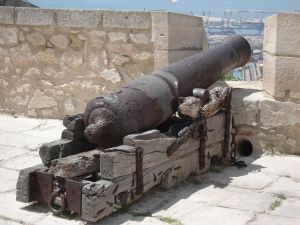Check one or more of the categories listed below to see them displayed on the map:
If you have any suggestions to new places to include in our map please click here (it only takes a couple of minutes).
Click on the icons displayed on the map for details. You can zoom in or out by using the + / - buttons at the top left corner or with the scroll feature on your mouse.
Monuments in Alicante
Ayuntamiento
Location: Plaza del Ayuntamiento, 1
Alicante’s city hall was finished in 1760; it was built using baroque style, like many other buildings in Alicante. An interesting artefact to see inside the building is the first step on the stairway to the first floor. There is a metal disc that indicates the sea level and it is used to measure the height of the sea level throughout all of Spain.
Castillo de Santa Bárbara
 Location: Summit of Mount Benacantil
Location: Summit of Mount Benacantil
The history of this castle goes back several centuries. Findings have led archaeologists to believe it was once the site of an Iberian fort. Most of the castle that remains today dates back to about the 16th century. From the castle, sitting 166m above sea level, there is a magnificent view of the city and sea. The trip can be made in car or by a lift that is located on the Postiguet beach.
Castillo de San Fernando
Location: atop of the Tossal hill
This castle is quite different from other historic sites because it was never completed in the first place. Building on the castle began just before the French invaded the land, therefore today all that is left is a large podium. Today the space is used for sport and leisure activities.
Concatedral de San Nicolás de Bari
Location: Plaza Abad Penalva
This church is one of the best examples in Spain of high baroque style because of some of its elegant features. The church was finished in 1662 and has many magnificent chapels that reflect the richness of the neighbourhood where it is located. The large wooden doors are among the wonderful aspects to see in this church.
Iglesia de Santa Maria
Location: Plaza de Santa Maria
16th century church that is set on the site of an Arabian mosque. The church has a gothic interior with baroque-era features also present.
Isla de Tabarca
The Island of Tabarca is the only inhabited island that is a part of Valencia. It is a natural monument itself and sits 11 nautical miles from Alicante. The waters surrounding the island are listed as a Marine Reserve and in 1964 the Island was recognized as a Historical-ArtisticMonument. The Island has a long history, as it was once a retreat for pirates, there is also an 18th century church and the castle of San José.
Monasterio de la Santa Faz
Location: Village of Santa Faz (eight kilometres outside of Alicante)
Completed in 1766, in a mix of renaissance and baroque architecture, this monastery contains a chapel that is the home to a relic from the time of Christ. Brought from Rome in the 15th century, the church houses a piece of linen that was used by Veronica to wipe Christ’s face on the walk to Calvary.
Location: Calle Gravina, 13-15
This 18th century building is home to the provincial Archives, which are governed by the provincial Council. It is an interesting site to see; often times there are cultural events and exhibitions here as well.